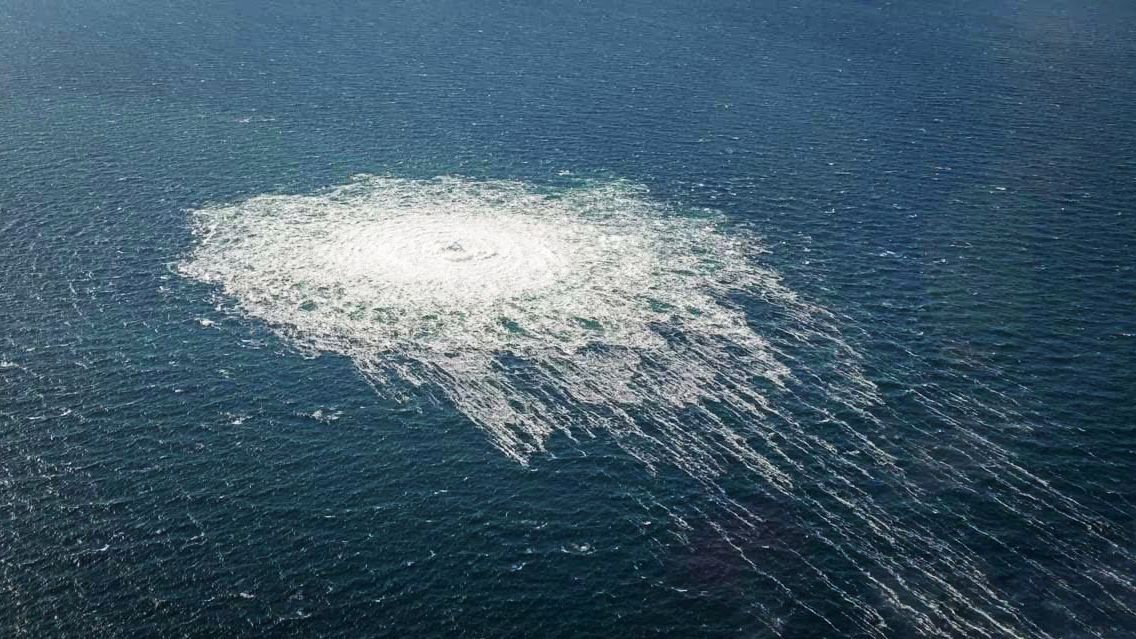oman käsityksen mukaan sitä betonia on vain tietyissä paikoissa, ei kaikkialla.The Nord Stream gas pipelines are colossal pieces of infrastructure. Running more than 1,200 kilometers from Russia, across the Baltic Sea to Germany, the pipes can carry up to 110 billion cubic meters of gas, enough for 26 million homes. The Nord Stream 1 pipeline alone is constructed of 202,000 huge pieces of piping. Each section is 12 meters long and contains piping that uses around 4 centimeters of steel, which is covered with 11 centimeters of concrete. The pipes are not built to break.

The Race to Find the Nord Stream Saboteurs
Damage to the pipeline that runs between Russia and Germany is being treated as deliberate. Finding out what happened may not be straightforward.
While officials have indicated the leaks may have been caused deliberately, very little evidence about the attacks has emerged so far. Military flights over the region show gas bubbling at the surface more than a kilometer wide, and Swedish seismic experts say they are convinced explosions took place after they recorded tremors equal to a magnitude 2.3 earthquake.
Fingers immediately pointed at Russia, which partly owns the pipes. Ukraine has said it is a “terrorist attack,” and German newspaper Der Spiegel reported that the CIA warned German officials about possible attacks against Baltic pipelines several weeks ago. (Right-wing commentators in the US and one Polish MP accused the US of being involved after President Joe Biden said, in February, he would “put an end” to Nord Stream 2 if Russia invaded Ukraine.)
"It's a very classic Russian hybrid warfare approach,” says Hans Tino Hansen, the CEO of Risk Intelligence, a Denmark-based security firm that deals with maritime issues. Hansen says if Russia did attack the Nord Stream pipelines it would show they have “complete deniability.” Because Russia partly owns the Nord Stream infrastructure, it makes people question why it would be behind any attacks against it.
Neither of the pipes is operational—Nord Stream 1 was paused for repairs in August and Nord Stream 2 has not officially opened after Germany pulled support for it ahead of Russia’s full-scale invasion of Ukraine in late February—but both pipes are holding gas. All three leaks happened relatively close to each other, near the Danish island of Bornholm, in the Baltic sea. The island is surrounded by Denmark to the west, Sweden to the north, and both Germany and Poland to the south. The leaks are in international waters, but also sit in both Denmark and Sweden’s exclusive economic zones. “It's quite shallow, around 50 meters on average in this region,” says Julian Pawlak, a research associate at the Helmut Schmidt University and the German Institute for Defence and Strategic Studies.
Eli putket on niin matalalla että suve taikka iso sukeltaja projekti näkyisi myös ponnalla liikkujille. Viritetty sika on loogisin vehje.Back in 2007, before the first Nord Stream pipeline was constructed, a review of the project by the Swedish Defence Research Agency (FOI) warned about potential explosions around the pipe, in the context of terrorism. “Despite its concrete coating, a pipeline is rather vulnerable, and one diver would be enough to set an explosive device,” its report said. “However, the impact of such an assault would probably be rather modest and most likely a minor incident of this type would not result in a large explosion.”
"They [Russia] have the capability for subsea warfare, with the divers, but also with mini-submarines and drones,” Hansen says. However, confirming any responsibility isn’t necessarily straightforward. The relatively shallow depth of the area around the Nord Stream pipes means it is unlikely that any large submarines would have been operating nearby, as they would be easy to detect.
Pawlak says any vessels in the area could potentially detect others that may have caused the damage. Undersea sensors could equally spot something in the area moving, but it is unclear where any of these systems are. “It's still not the case that all of the Baltic Sea is filled up with sensors and that NATO knows every movement,” Pawlak says. “On the surface, but especially on the seabed, it's still not possible to know, at every time, at every place, what's moving, what's going on.”
Hansen says there are two starting points for protecting subsea infrastructure: first, building out ways to detect faults and issues with equipment automatically and then also making sure there is equipment, such as underwater drones, that are able to scramble to sites to inspect them when damage has happened. Those steps may already be underway, with Norway’s prime minister saying the country will up the military protection of its energy infrastructure.



